Wellbeing Concepts Report: Presentation & Individual Role
VerifiedAdded on 2021/06/14
|5
|989
|29
Report
AI Summary
This report provides an overview of the individual's contribution to a group presentation on wellbeing, detailing the key concepts and elements discussed. The presentation explored the multifaceted nature of wellbeing, encompassing emotional, mental, and spiritual aspects, and highlighted the influence of social determinants of health. The report emphasizes the importance of patient-centered care and cultural competence in healthcare settings, advocating for tailored interventions such as mindfulness-based practices to promote behavioral change and improve individual wellbeing. It also discusses the impact of stressors and the need for interventions to address challenges faced by individuals. The report references various studies to support its arguments and concludes with a call for interventions that promote physical and psychological health.
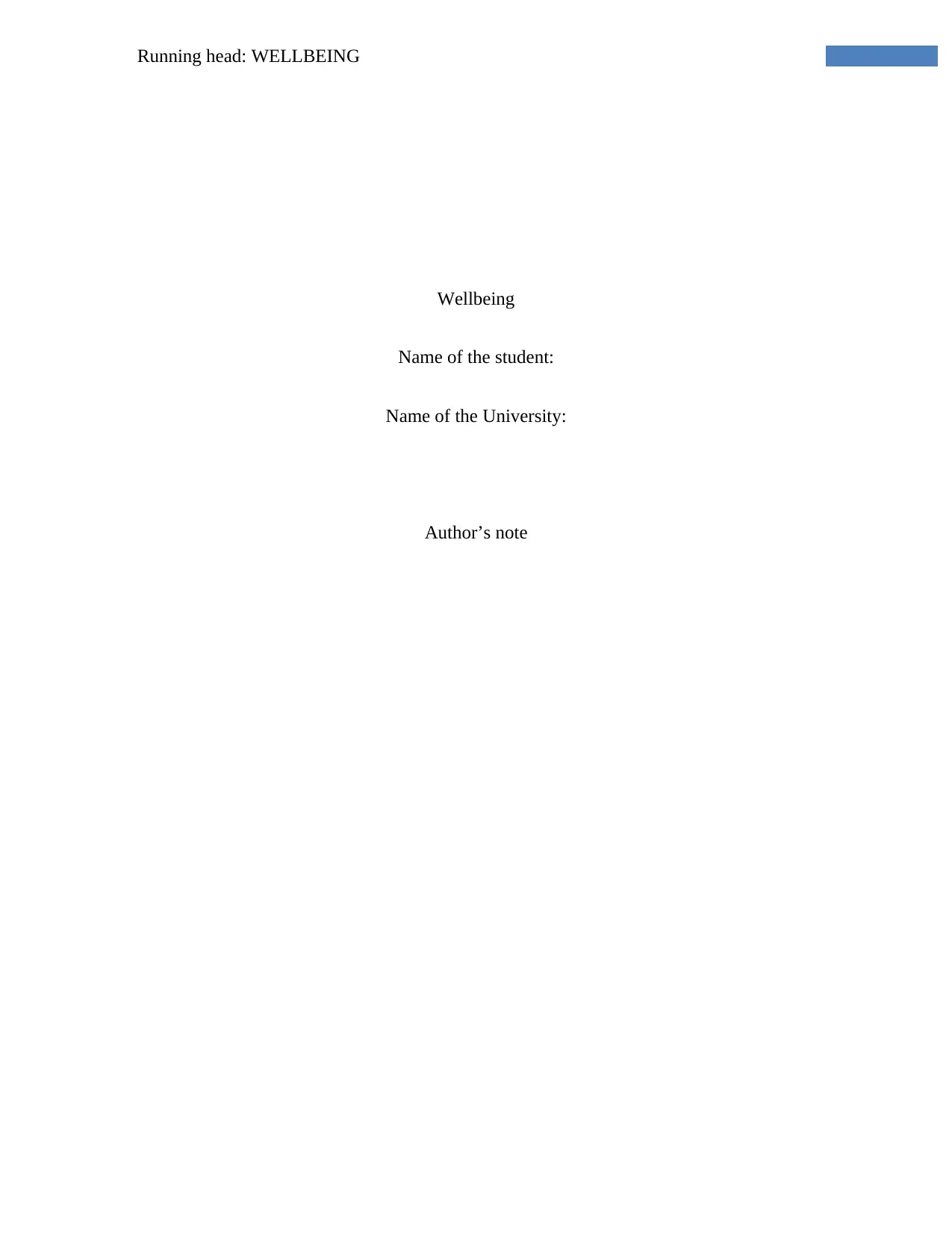
Running head: WELLBEING
Wellbeing
Name of the student:
Name of the University:
Author’s note
Wellbeing
Name of the student:
Name of the University:
Author’s note
Paraphrase This Document
Need a fresh take? Get an instant paraphrase of this document with our AI Paraphraser
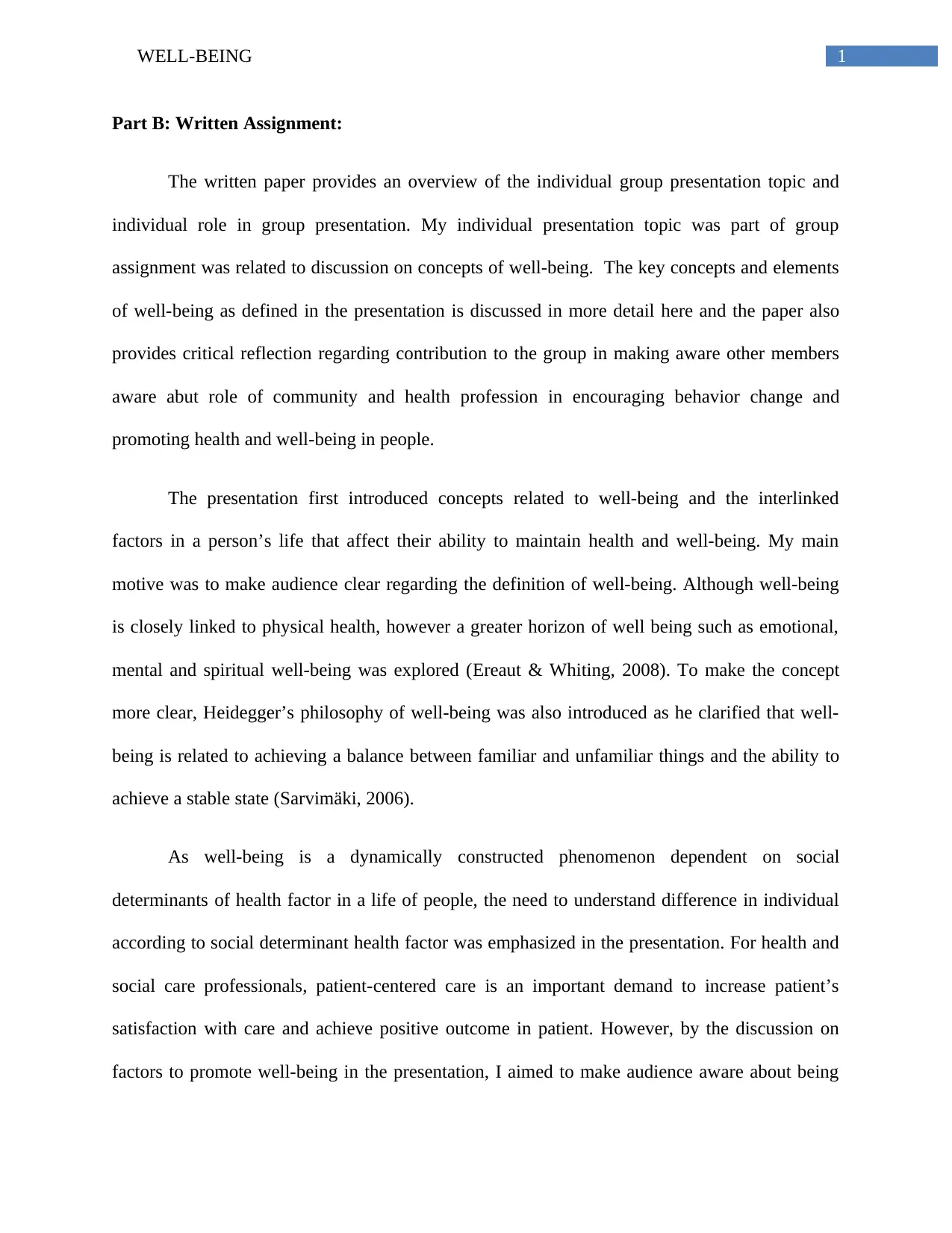
1WELL-BEING
Part B: Written Assignment:
The written paper provides an overview of the individual group presentation topic and
individual role in group presentation. My individual presentation topic was part of group
assignment was related to discussion on concepts of well-being. The key concepts and elements
of well-being as defined in the presentation is discussed in more detail here and the paper also
provides critical reflection regarding contribution to the group in making aware other members
aware abut role of community and health profession in encouraging behavior change and
promoting health and well-being in people.
The presentation first introduced concepts related to well-being and the interlinked
factors in a person’s life that affect their ability to maintain health and well-being. My main
motive was to make audience clear regarding the definition of well-being. Although well-being
is closely linked to physical health, however a greater horizon of well being such as emotional,
mental and spiritual well-being was explored (Ereaut & Whiting, 2008). To make the concept
more clear, Heidegger’s philosophy of well-being was also introduced as he clarified that well-
being is related to achieving a balance between familiar and unfamiliar things and the ability to
achieve a stable state (Sarvimäki, 2006).
As well-being is a dynamically constructed phenomenon dependent on social
determinants of health factor in a life of people, the need to understand difference in individual
according to social determinant health factor was emphasized in the presentation. For health and
social care professionals, patient-centered care is an important demand to increase patient’s
satisfaction with care and achieve positive outcome in patient. However, by the discussion on
factors to promote well-being in the presentation, I aimed to make audience aware about being
Part B: Written Assignment:
The written paper provides an overview of the individual group presentation topic and
individual role in group presentation. My individual presentation topic was part of group
assignment was related to discussion on concepts of well-being. The key concepts and elements
of well-being as defined in the presentation is discussed in more detail here and the paper also
provides critical reflection regarding contribution to the group in making aware other members
aware abut role of community and health profession in encouraging behavior change and
promoting health and well-being in people.
The presentation first introduced concepts related to well-being and the interlinked
factors in a person’s life that affect their ability to maintain health and well-being. My main
motive was to make audience clear regarding the definition of well-being. Although well-being
is closely linked to physical health, however a greater horizon of well being such as emotional,
mental and spiritual well-being was explored (Ereaut & Whiting, 2008). To make the concept
more clear, Heidegger’s philosophy of well-being was also introduced as he clarified that well-
being is related to achieving a balance between familiar and unfamiliar things and the ability to
achieve a stable state (Sarvimäki, 2006).
As well-being is a dynamically constructed phenomenon dependent on social
determinants of health factor in a life of people, the need to understand difference in individual
according to social determinant health factor was emphasized in the presentation. For health and
social care professionals, patient-centered care is an important demand to increase patient’s
satisfaction with care and achieve positive outcome in patient. However, by the discussion on
factors to promote well-being in the presentation, I aimed to make audience aware about being
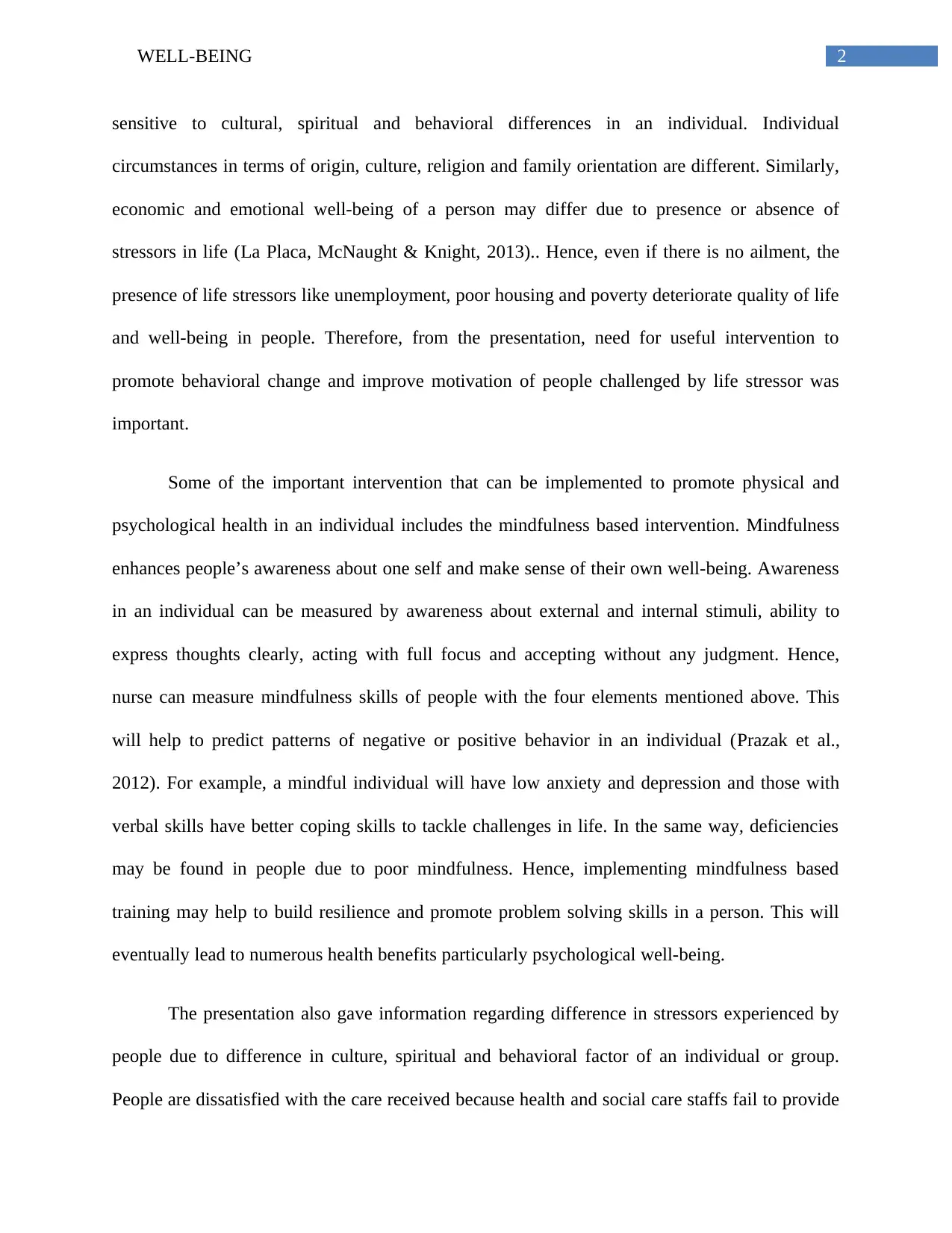
2WELL-BEING
sensitive to cultural, spiritual and behavioral differences in an individual. Individual
circumstances in terms of origin, culture, religion and family orientation are different. Similarly,
economic and emotional well-being of a person may differ due to presence or absence of
stressors in life (La Placa, McNaught & Knight, 2013).. Hence, even if there is no ailment, the
presence of life stressors like unemployment, poor housing and poverty deteriorate quality of life
and well-being in people. Therefore, from the presentation, need for useful intervention to
promote behavioral change and improve motivation of people challenged by life stressor was
important.
Some of the important intervention that can be implemented to promote physical and
psychological health in an individual includes the mindfulness based intervention. Mindfulness
enhances people’s awareness about one self and make sense of their own well-being. Awareness
in an individual can be measured by awareness about external and internal stimuli, ability to
express thoughts clearly, acting with full focus and accepting without any judgment. Hence,
nurse can measure mindfulness skills of people with the four elements mentioned above. This
will help to predict patterns of negative or positive behavior in an individual (Prazak et al.,
2012). For example, a mindful individual will have low anxiety and depression and those with
verbal skills have better coping skills to tackle challenges in life. In the same way, deficiencies
may be found in people due to poor mindfulness. Hence, implementing mindfulness based
training may help to build resilience and promote problem solving skills in a person. This will
eventually lead to numerous health benefits particularly psychological well-being.
The presentation also gave information regarding difference in stressors experienced by
people due to difference in culture, spiritual and behavioral factor of an individual or group.
People are dissatisfied with the care received because health and social care staffs fail to provide
sensitive to cultural, spiritual and behavioral differences in an individual. Individual
circumstances in terms of origin, culture, religion and family orientation are different. Similarly,
economic and emotional well-being of a person may differ due to presence or absence of
stressors in life (La Placa, McNaught & Knight, 2013).. Hence, even if there is no ailment, the
presence of life stressors like unemployment, poor housing and poverty deteriorate quality of life
and well-being in people. Therefore, from the presentation, need for useful intervention to
promote behavioral change and improve motivation of people challenged by life stressor was
important.
Some of the important intervention that can be implemented to promote physical and
psychological health in an individual includes the mindfulness based intervention. Mindfulness
enhances people’s awareness about one self and make sense of their own well-being. Awareness
in an individual can be measured by awareness about external and internal stimuli, ability to
express thoughts clearly, acting with full focus and accepting without any judgment. Hence,
nurse can measure mindfulness skills of people with the four elements mentioned above. This
will help to predict patterns of negative or positive behavior in an individual (Prazak et al.,
2012). For example, a mindful individual will have low anxiety and depression and those with
verbal skills have better coping skills to tackle challenges in life. In the same way, deficiencies
may be found in people due to poor mindfulness. Hence, implementing mindfulness based
training may help to build resilience and promote problem solving skills in a person. This will
eventually lead to numerous health benefits particularly psychological well-being.
The presentation also gave information regarding difference in stressors experienced by
people due to difference in culture, spiritual and behavioral factor of an individual or group.
People are dissatisfied with the care received because health and social care staffs fail to provide
⊘ This is a preview!⊘
Do you want full access?
Subscribe today to unlock all pages.

Trusted by 1+ million students worldwide
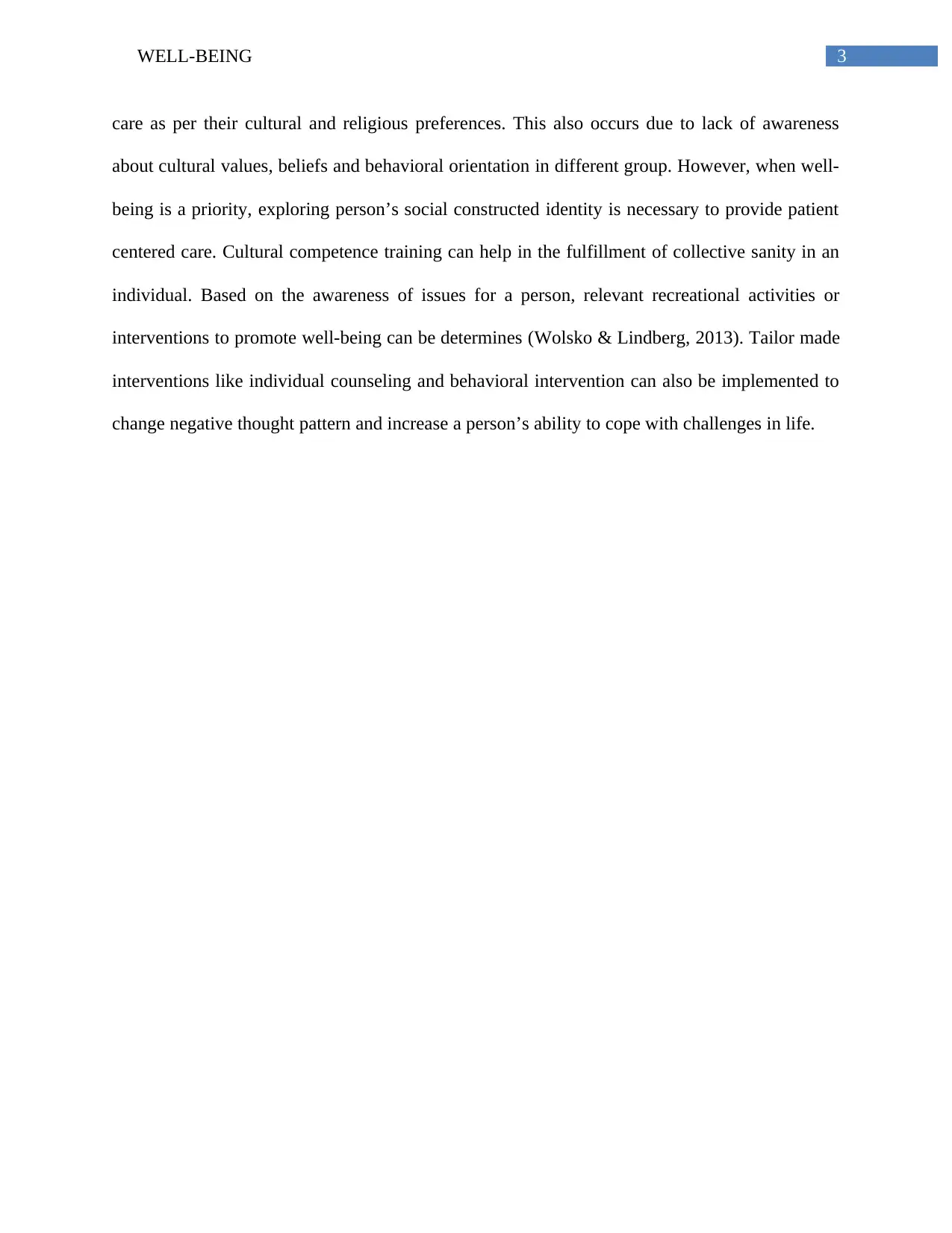
3WELL-BEING
care as per their cultural and religious preferences. This also occurs due to lack of awareness
about cultural values, beliefs and behavioral orientation in different group. However, when well-
being is a priority, exploring person’s social constructed identity is necessary to provide patient
centered care. Cultural competence training can help in the fulfillment of collective sanity in an
individual. Based on the awareness of issues for a person, relevant recreational activities or
interventions to promote well-being can be determines (Wolsko & Lindberg, 2013). Tailor made
interventions like individual counseling and behavioral intervention can also be implemented to
change negative thought pattern and increase a person’s ability to cope with challenges in life.
care as per their cultural and religious preferences. This also occurs due to lack of awareness
about cultural values, beliefs and behavioral orientation in different group. However, when well-
being is a priority, exploring person’s social constructed identity is necessary to provide patient
centered care. Cultural competence training can help in the fulfillment of collective sanity in an
individual. Based on the awareness of issues for a person, relevant recreational activities or
interventions to promote well-being can be determines (Wolsko & Lindberg, 2013). Tailor made
interventions like individual counseling and behavioral intervention can also be implemented to
change negative thought pattern and increase a person’s ability to cope with challenges in life.
Paraphrase This Document
Need a fresh take? Get an instant paraphrase of this document with our AI Paraphraser
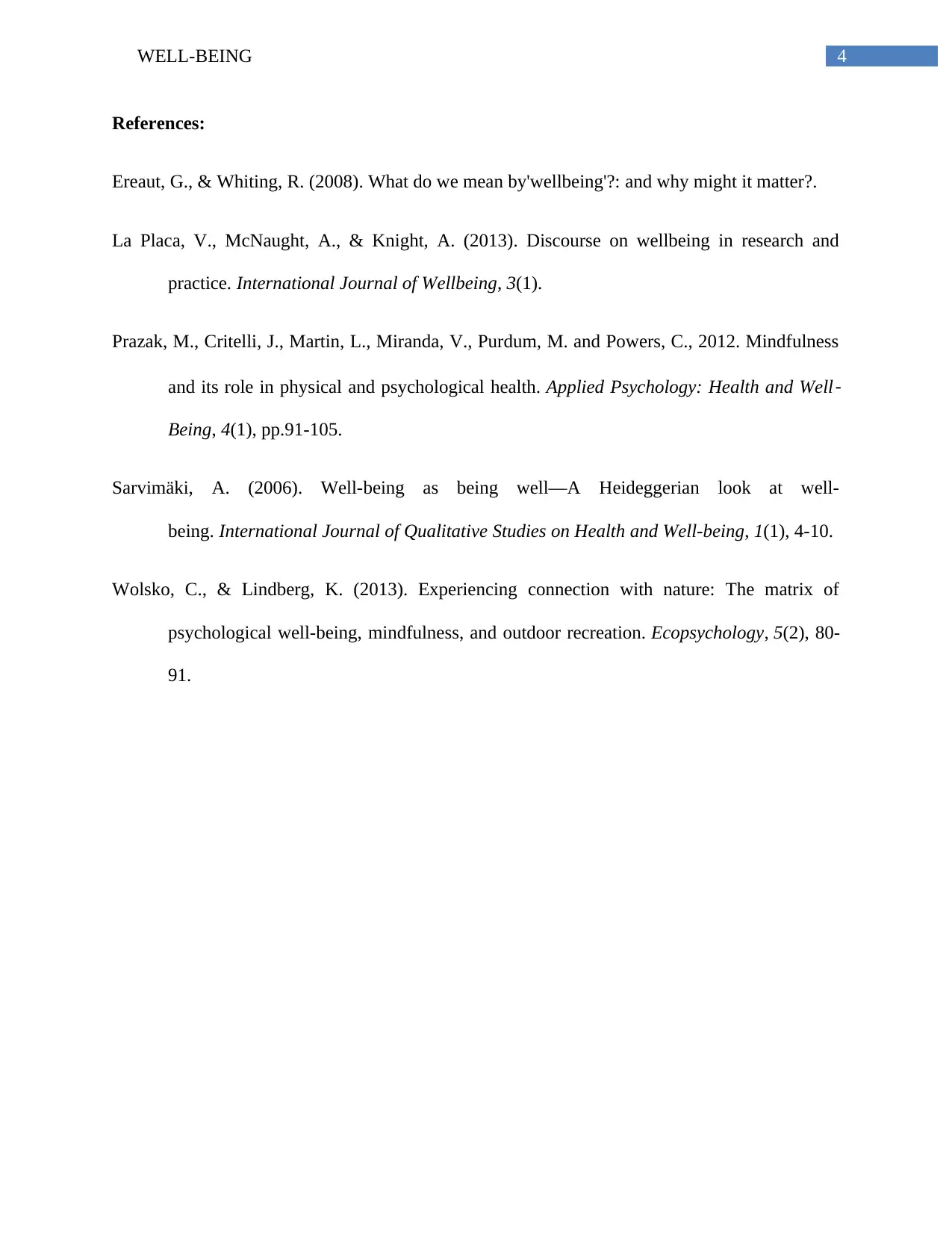
4WELL-BEING
References:
Ereaut, G., & Whiting, R. (2008). What do we mean by'wellbeing'?: and why might it matter?.
La Placa, V., McNaught, A., & Knight, A. (2013). Discourse on wellbeing in research and
practice. International Journal of Wellbeing, 3(1).
Prazak, M., Critelli, J., Martin, L., Miranda, V., Purdum, M. and Powers, C., 2012. Mindfulness
and its role in physical and psychological health. Applied Psychology: Health and Well
‐
Being, 4(1), pp.91-105.
Sarvimäki, A. (2006). Well-being as being well—A Heideggerian look at well-
being. International Journal of Qualitative Studies on Health and Well-being, 1(1), 4-10.
Wolsko, C., & Lindberg, K. (2013). Experiencing connection with nature: The matrix of
psychological well-being, mindfulness, and outdoor recreation. Ecopsychology, 5(2), 80-
91.
References:
Ereaut, G., & Whiting, R. (2008). What do we mean by'wellbeing'?: and why might it matter?.
La Placa, V., McNaught, A., & Knight, A. (2013). Discourse on wellbeing in research and
practice. International Journal of Wellbeing, 3(1).
Prazak, M., Critelli, J., Martin, L., Miranda, V., Purdum, M. and Powers, C., 2012. Mindfulness
and its role in physical and psychological health. Applied Psychology: Health and Well
‐
Being, 4(1), pp.91-105.
Sarvimäki, A. (2006). Well-being as being well—A Heideggerian look at well-
being. International Journal of Qualitative Studies on Health and Well-being, 1(1), 4-10.
Wolsko, C., & Lindberg, K. (2013). Experiencing connection with nature: The matrix of
psychological well-being, mindfulness, and outdoor recreation. Ecopsychology, 5(2), 80-
91.
1 out of 5
Related Documents
Your All-in-One AI-Powered Toolkit for Academic Success.
+13062052269
info@desklib.com
Available 24*7 on WhatsApp / Email
![[object Object]](/_next/static/media/star-bottom.7253800d.svg)
Unlock your academic potential
Copyright © 2020–2025 A2Z Services. All Rights Reserved. Developed and managed by ZUCOL.





